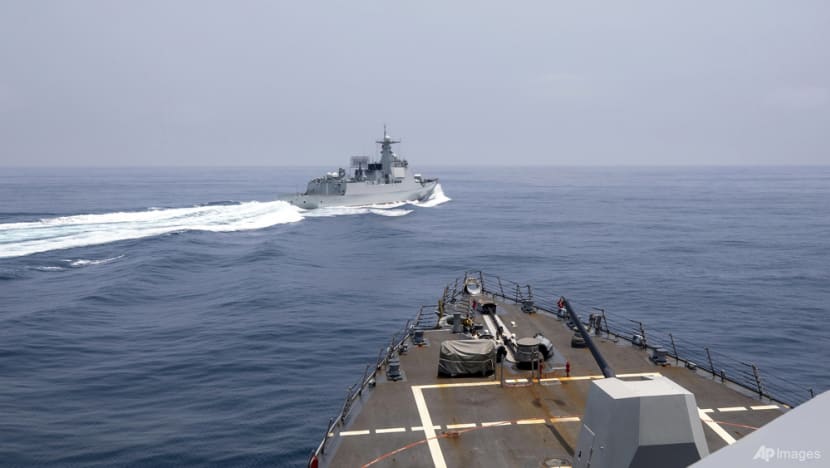Commentary: US, China and a Cold War lesson to apply 'rules of the road' at sea
Soviet and American warships had a system set up during the Cold War to prevent dangerous encounters. The US and China should have the same, says this international law expert.

CANBERRA: The most recent Taiwan Strait incident between the US Navy and the PLA Navy have not only highlighted how determined both sides are to advance their positions in the Strait, but also how such a close encounter could so quickly escalate into a very serious maritime, diplomatic and political episode.
A US military statement reports that on Jun 3, the USS Chung-Hoon and the accompanying Canadian warship HMCS Montreal were passing through the Taiwan Strait on “a routine south to north Taiwan Strait transit … through waters where high seas freedoms of navigation and overflight apply”.
The US asserts that during the transit, Chinese navy warship LY 132 “executed manoeuvres in an unsafe manner in the vicinity of Chung-Hoon … overtook Chung-Hoon on their port side and crossed their bow at 150 yards”.
The position of the United States is that the actions of the Chinese vessel “violated the maritime Rules of the Road of safe passage in international waters”.
This version of events is confirmed by the video released of the incident by Canadian journalists travelling with the Montreal, and China’s response during the 2023 IISS Shangri-La Dialogue that was taking place at the same time. There has been no suggestion by China that the incident took place within the Chinese claimed 12 nautical mile territorial sea.
Given these events, what are the rights and entitlements of foreign navies to transit the Taiwan Strait, and what can be done to avoid these high-risk maritime encounters occurring?
UNLIKE OTHER STRAITS
The Taiwan Strait is generally wide, narrowing to a distance of 64 nautical miles (119km) and extending 135 nautical miles (250km).
Even allowing for the 12 nautical mile (22km) territorial seas claimed off the Chinese mainland, Taiwan, and adjacent small islands, given the breadth of the Taiwan Strait legally it is one in which there exists either an exclusive economic zone or a high seas corridor.
Unlike Bass Strait, Torres Strait, and the Straits of Malacca and Singapore, the Taiwan Strait is not governed by certain provisions of the 1982 United Nations Convention on the Law of the Sea (UNCLOS) that recognise the right of transit passage through recognised “international straits”.
The Taiwan Strait is so wide that there is no need for passing vessels to enter the territorial sea, and consistent with UNCLOS exclusive economic zone or high seas navigation can safely be undertaken through the middle of the strait.
AN INTERNATIONAL MARITIME HIGHWAY
The strait is therefore effectively a form of international maritime highway because of its breadth. The US position that high seas freedoms of navigation apply in the Taiwan Strait is a view shared by other foreign navies, including Australia.
The so-called maritime “rules of the road” in this instance are embedded in the COLREGS (Collision Regulations), which lay down accepted practices and standards for how all shipping is to conduct itself so as to avoid collisions at sea.
These rules are ones that navies apply and respect during peacetime, and are generally considered to be the baseline standard of professional conduct for all mariners at sea.
Are there frameworks and mechanisms to avoid a naval collision between China and the US, and the inevitable tensions that would erupt following such an incident?
TAKING A PAGE OUT OF THE COLD WAR
On his return from the Shangri-La Dialogue in Singapore, Prime Minister Anthony Albanese has put forward a proposal that has its roots in Cold War practice.
He told the ABC that “during the Cold War between the United States and the Soviet Union, there were systems set up so that a misadventure or miscalculation didn’t lead to disastrous consequences. The concern here is that the guardrails are not in place. So the consequences of a misinterpretation or an accident occurring, and it leading to a reaction and then a further action is something that is very dangerous”.
Albanese urged China and the US to have open communications about these matters and to consider putting bilateral arrangements in place.
The US and the former USSR did have maritime guardrails in place during the Cold War and these were effective. They extended from bilateral INCSEA (Incidents at Sea) arrangements agreed during the 1970s, to the 1989 Jackson Hole Agreement on the Uniform Interpretation of Rules of International Law Governing Innocent Passage.
These mutually agreed interpretations of the law of the sea and associated maritime rules of the road dampened down Cold War maritime tensions and ensured there were no significant naval clashes. These are the types of Cold War examples Albanese would have been referring to.
US AND CHINA SHOULD HAVE THEIR OWN MARITIME GUARDRAILS
To date, there are no equivalent maritime understandings between China and the United States. One regional initiative was promoted.
The 2014 Code for Unplanned Encounters at Sea (CUES), was signed by 21 Pacific nations at the 14th Western Pacific Naval Symposium in Qingdao, China. CUES is a series of non-binding rules-of-the-road to prevent an escalation of tensions between different militaries at sea, and references the COLREGS.
However, notwithstanding Chinese and US endorsement, CUES has had little real impact as highlighted by the recent incident.
Australia is right to promote bilateral dialogue between China and the United States over these maritime matters. There is a Cold War track record of mutually beneficial outcomes from such negotiations, which would also have value for the Indo-Pacific.
Given their entrenched positions, however, getting over the hurdle of the Taiwan Strait may be the blockage that impairs the advancement of any such talks.
Donald R Rothwell is Professor of International Law, Australian National University. This commentary first appeared on the Lowy Institute’s blog, The Interpreter.















